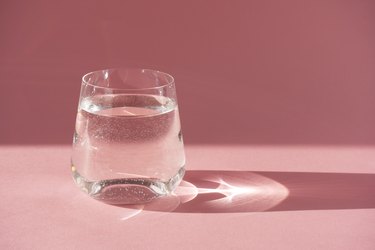
Though sodium bicarbonate, also known as baking soda, makes a great household cleaner, it leaves a residue behind if you don't rinse it off surfaces. In most cases, removing sodium bicarbonate from glass is as simple as wiping the glass down with white vinegar, or even with water. Use baking soda all around the house in place of chemical-based cleansers, then be sure to wipe off the residue soon afterwards.
Baking Soda for Glass Stovetops
Video of the Day
Using harsh chemical cleaners on a glass stovetop might remove stubborn messes, but the products could also damage the glass. Instead, wait until the glass is cool to the touch, then spray a little hot water over the baked-on mess. Sprinkle sodium bicarbonate liberally over the spot, then place a warm, damp cleaning cloth over the baking soda. After 15 minutes, gently scrub the area with the damp cloth, letting the abrasive power of the baking soda do the work.
Video of the Day
Rinse the cloth frequently, then continue wiping the area to remove all residue from both the baked-on mess and the baking soda. Spritz the glass with white vinegar, then wipe it away with a soft lint-free cloth, such as microfiber.
This same baking-soda cleaning solution works on glass oven doors, microwave doors and the tray inside the microwave. For vertical glass, instead spritz the surface with vinegar first, sprinkle some baking soda on a damp, soft cloth, then gently scrub the spots. Rinse the cloth and wipe the area down again, then spray on more vinegar, ultimately wiping it away to remove any lingering residue.
Removing Baking Soda From Glass
If any glass surfaces in your home already have sodium bicarbonate residue on them, vinegar is the answer. Spray white vinegar on the residue, which may create foam as the two materials react. Wait a minute or two, then wipe the mess away with a damp sponge or a lint-free damp cloth. If the baking soda is heavily caked onto a glass surface, rub off as much as possible with a soft cloth, followed by a soft, damp cloth. Picking at it with a fingernail also helps.
Spraying a glass surface with a mist of vinegar removes all sorts of buildup, including calcium or lime deposits as well as baking soda. Spray all of the residue with a fair amount of vinegar, wiping up any drips if spraying on a vertical surface. Wait a couple minutes, then wipe the vinegar and the residue away with a damp cloth, or even a cloth dipped in vinegar and wrung out to remove excess moisture.
Vinegar is great for removing streaks and restoring a shiny, clear finish to virtually any household glass surface, and it's safe even for glassware and glass cooking vessels. Vinegar's aroma dissipates quickly, but if you're not a fan of the scent when working in a tight space such as a shower stall, open the windows first and keep them open for another 10 minutes or so after finishing the cleanup project. Vinegar also evaporates relatively quickly, so if you're letting it sit on a surface, don't wait too long or you'll have to spray more vinegar.